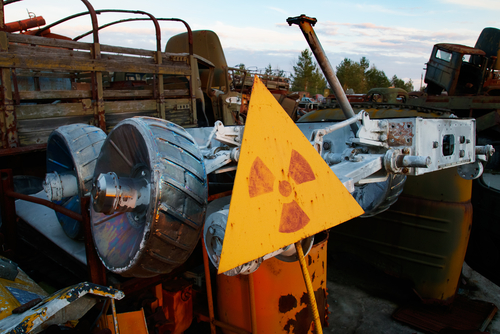Chernobyl: What happened and why?
Thirty-two years after the explosions at the Ukrainian nuclear power plant, we revisit the disaster and its legacy.
Exactly 32 years ago, explosions at the then-Soviet Chernobyl Nuclear Power Plant set off what has been described as the world’s worst nuclear disaster.
The blasts released large levels of radiation into the atmosphere, forcing thousands to flee their homes and sparking major fears over long-term health consequences and environmental destruction.
In the decades that followed, wildlife has flourished in the area, which has become a popular tourist attraction.
Here, we explain what happened, why and what Chernobyl is like today.
Where is Chernobyl?
- The Chernobyl plant is located some 100km from Ukraine’s capital, Kiev, and about 20km from the border with Belarus.
- The nearest town is the now-abandoned Pripyat, which was purpose-built in 1970 to house workers from the plant and was home to between 40,000 and 50,000 people.
- At the time of the explosion, Ukraine was part of the Soviet Union.
What happened there?
- In the early hours of April 26, 1986, one of four nuclear reactors at the plant exploded.
- The explosions occurred during a test designed to check the Unit 4 reactor’s cooling functions on limited power. The power-regulating and safety systems were both shut off before the test to avoid interruptions.
- The reactor was to supposed to run at 25 percent capacity during the test but dipped to less than one percent, forcing workers to slowly increase the power levels.
-
- An unexpected power surge caused fuel pellets in the reactor to explode, triggering a larger explosion that blew the 1,000-tonne roof off of the reactor.
- A cloud of radioactive material was released into the atmosphere, while air mixing with carbon monoxide gas in the reactor ignited, causing a fire that burned for nine days.
Reaction
- Firefighters were initially deployed to pour water into the reactor, before being replaced by military helicopters that dropped more than 2,400 tonnes of lead and 1,800 tonnes of sand in an attempt to smother the fire and absorb the radiation.
- On April 27, a 30km circular area surrounding the plant was designated as The Chernobyl Nuclear Power Plant Zone of Alienation, also known as the Exclusion Zone.
- The 116,000 people living in the Exclusion Zone were evacuated and the area was put under military control. The zone was later expanded to cover a wider area and a further 230,000 people were relocated.
- Thousands of people were involved in attempts to contain the disaster, risking their health as a result. These people have come to be known as “liquidators”.
- A hastily-constructed “sarcophagus” dome made of steel and concrete was built over the reactor to stop the release of radiation into the atmosphere. Completed in November 1986, the dome fell into disrepair, prompting safety concerns and was replaced with a moveable metal structure in 2016.
- The Soviet Union was slow to acknowledge the severity of the incident until pressed to explain the unusually high levels of wind-transported radioactivity detected by monitoring stations in Sweden following the explosion. On April 28, a 20-second television announcement was made acknowledging the incident.
- In 2000, the plant was officially decommissioned.
How many people died?
- At least two people were killed as a result of the initial explosions.
-
- The extent of the health impact of the disaster remains highly controversial as, in some cases, it is difficult to isolate radiation as the singular cause of death or disease.
- According to the World Health Organization, around five million people are currently living in areas of Belarus, Russia and Ukraine with high levels of radiation.
- More than 130 people who were either on-site at the time of the explosion or involved in the initial clean-up operation were confirmed as suffering from Acute Radiation Syndrome (ARS).
- Of these 134 people, 28 died within a few weeks of the incident.
- There has been a large increase in thyroid cancer among people who were children living in the most contaminated areas at the time of the explosion, with some 5,000 cases detected across Russia, Ukraine and Belarus. This is due to consumption of milk from cows that grazed on pastures contaminated with radioactive iodine.
What were the environmental effects?
- The explosions released 400 times more radiation than the atomic bomb dropped on Hiroshima during the Second World War, according to the International Atomic Energy Agency.
- Fallout travelled across Europe, reaching as far as Scandinavia and the United Kingdom, where some farms faced post-Chernobyl restrictions until as recently as 2012.
- The Exclusion Zone remains one of the most radioactive places on Earth.
-
- In the absence of humans, dense woodland has sprung up, allowing wildlife to flourish.The Chernobyl International Radioecology Laboratory has recorded sightings of more than 400 animal species in the area, including 50 endangered species.
- Estimates of when Chernobyl might be habitable for humans vary wildly, from a few hundred to 20,000 years.
Is it safe to go the Exclusion Zone?
- In 2011, the Exclusion Zone was officially declared a tourist attraction by the Ukrainian government.
- The site attracts thousands of visitors each year, with almost 50,000 people visiting in 2017. It has become synonymous with “dark tourism”, which involves travelling to places associated with death or suffering.
- Despite high levels of radiation, thousands returned to their homes within the Exclusion Zone in the years following the disaster, while some never left.
- Around 200 people currently live in the Exclusion Zone. Known as “samosely” or “self-settlers”, they are mostly elderly people who made their home in the area before the disaster and refuse to leave.

